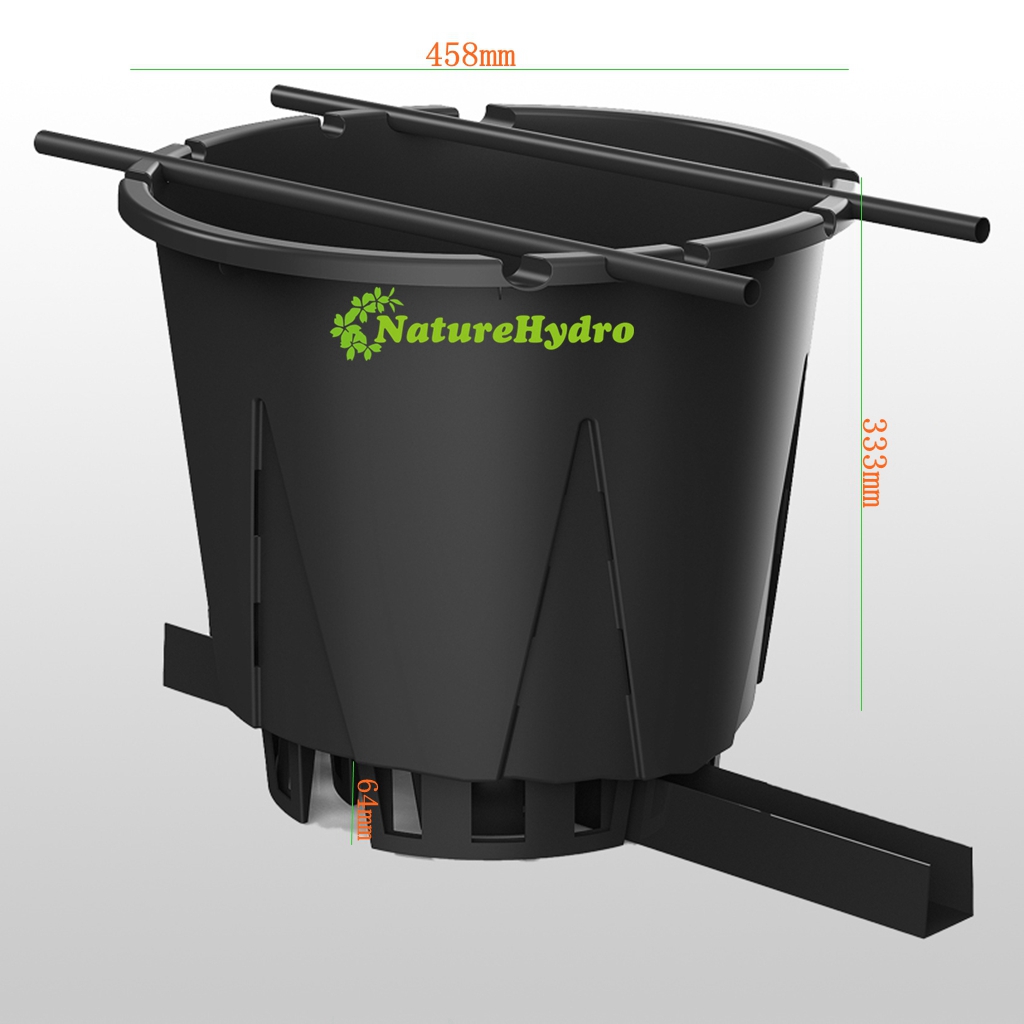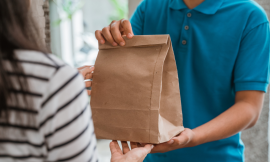Container preference is often a matter of convenience, cost, and availability. But the size, shape, and color of a container can affect the size and health of a plant as well as the versatility of the garden. Containers come in all shapes and sizes and can be constructed of almost anything – clay, metal, plastic, wood, and wood fiber are the most common. Plants will grow in any clean container that has not been used for petroleum products or deadly chemicals.
Clay, fiber, and wood containers breathe better than plastic or metal pots. Heavy clay pots are brittle and absorb moisture from the soil inside, causing the soil to dry out quickly. Metal pots are also impractical for indoor gardens because they oxidize (rust) and can bleed off harmful elements and compounds. Wood, although somewhat expensive, makes some of the best containers, especially large raised beds and planters on wheels. Plastic containers are inexpensive, durable, and offer the best value to indoor gardeners.
Rigid plastic pots are the most commonly used containers in indoor gardens. Growing in inexpensive, readily available containers is brilliant because they allow each plant to be cared for individually. You can control each plant’s specific water and nutrient regimen. Individual potted plants can also be moved. Turn pots every few days, so plants receive even lighting and foliage will grow evenly. Huddle small, containerized plants tightly together under the brightest area below the HID lamp, and move them further apart as they grow. Set small plants up on blocks to move them closer to the HID. Individual plants are easily quarantined or dipped in a medicinal solution. Weak, sick, and problem plants are easy to cull from the garden.
Grow bags are among my favorite containers. Inexpensive, long-lasting grow bags take up little space and are light-weight. A box of 100 three-gallon (13 L) bags weighs less than five pounds (2.3 kg) and measures less than a foot square. One hundred three-gallon (13 L) grow bags can be stored in two-gallon (13 L) bags. Imagine storing 100 rigid pots in the same space.
Grow bags are very easy to wash and reuse. Empty out the soilless mix and submerge bags in a big container of soapy water overnight. Wash each one by hand the next day and fill with soil. I like them much better than rigid pots because they are so practical.
The potting soil sack can be used as a container. The moist soil inside the bag holds its shape well, and the bags expand and contract with the soil, lessening the chance of burned root tips that grow down the side of pots.
Fiber and paper-pulp pots are popular with gardeners who move their plants outdoors, but the bottoms of the pots habitually rot out. Painting the inside of the fiber container with latex paint will keep the bottom from rotting for several crops.
Set large pots on blocks or casters to allow air circulation underneath. The soil stays warmer, and maintenance is easier. Planters should be as big as possible but still allow easy access to plants. The roots have more room to grow and less container surface for roots to run into and grow down. With large pots, roots are able to intertwine and grow like crazy.
Garden beds can be installed right on the earthen floor of a garage or basement. If drainage is poor, a layer of gravel or a dry well can be made under the bed. Some gardeners use a jackhammer to remove the concrete floor in a basement to get better drainage. An easier option is to cut a hole in the basement floor and install a dry well. Knocking holes in basement floors could cause water seepage where water tables are high. When it rains, the water may collect underneath; the garden seldom needs watering, but plants are kept too wet.
A raised bed with a large soil mass can be built up organically after several crops. To hasten organic activity within the soil, add organic seaweed, manure, and additives. When mixing soil or adding amendments, use the best possible organic principles. There should be good drainage, and the soil should be as deep as possible, 12-14 inches (30-60cm).
Some gardeners in Amsterdam, Netherlands, grow in large soil beds set on a concrete floor. The basement beds are below sea level and filled with outstanding plants. They are able to treat the beds similarly to outdoor soil beds, but when watered heavily, water runs out on the floor and must be mopped up. They also have problems with ventilation. The ambient climate is naturally humid, and the extra water in the large basement increases humidity to above 90 percent, day and night. They employ a large extraction fan and a relatively small intake fan. Air is pulled through the long narrow basement room quickly and efficiently to evacuate moisture and lower the humidity. Even with this much soil ,they have to flush individual beds at least once every four weeks to avoid nutrient buildup.
Much heat can be generated by decomposing organic matter, and it warms the room. Ventilation lowers heat and humidity and helps keep the room free of pests and diseases. An organic indoor garden sounds great, but it is a lot of work to replicate the great outdoors. Most organic gardeners opt for organic liquid fertilizers and a bagged commercial organic soil mix.
Another drawback to raised beds is that the crop will take a few days longer to mature than if it were grown in containers. But the longer wait is offset by a larger harvest.
Container Shape, Size, and Maintenance
Popular pot shapes include rectangular and cylindrical. Gardeners prefer taller pots rather than wide, squat containers because many plant root systems penetrate deeply. Of all the gardens i have visited, squat pots were few and far between. Gardeners i queried said squat pots may hold more soil for their stature, but they do not produce as extensive a root system.
The volume of a container can easily dictate the size of a plant. For example, annual flowers and vegetables grow every fast and require a lot of root space for sustained, vigorous development. Containers should be big enough to allow for a strong root system, but just big enough to contain the root system before harvest. If the container is too small, roots are confined, water and nutrient uptake is limited, and growth slows to a crawl. But if the container is too big, it requires too much expensive growing medium and becomes heavy and awkward to move.
Fast-growing annuals’ roots develop and elongate quickly, growing down and out, away from the main taproot. For example, about midsummer, nurseries have unsold tomato plants that are still in small four-inch (10 cm) pots and one-gallon (4 L) containers. The stunted plants have blooming flowers and ripe fruit. But few branches extend much beyond the sides of the container; the plants are tall and leggy with curled-down leaves and an overall stunted, sickly appearance. These plants are potbound, or rootbound. Once a plant deteriorates to this level, it is often easier and more efficient to toss it out and replace it with a healthy one.
Roots soon hit the sides of containers where they grow down and mat up around the bottom. The unnatural environment inside the container often causes a thick layer of roots to grow alongside the container walls and bottom. This portion of the root zone is the most vulnerable to moisture and heat stress and is the most exposed.
When soil dries in a pot, it becomes smaller, contracting and separating from the inside of the container wall. This condition is worst in smooth plastic pots. When this crack develops, frail root hairs located in the gap quickly die when they are exposed to air whistling down this crevice. Water also runs straight down this crack and onto the floor. You may think the pot was watered, but the root ball remains dry. Avoid such killer cracks by cultivating the soil surface and running your finger around the inside lip of the pots. Cultivate the soil in pots every few days and maintain evenly moist soil to help keep root hairs on the soil perimeter from drying out.
Do not place containers in direct heat. If soil temperature climbs beyond 75 ℉ (24 ℃), it can damage roots. Pots that are in direct heat should be shaded with a piece of plastic or cardboard.
A one- to two-inch (3-5 cm) layer of hydroclay mulch on soil surface keeps soil surface, and the soil does not need to be cultivated. The mulch also decreases evaporation and helps keep irrigation water from damaging roots or splashing.
Naturehydro Plasitc Plant Containers
https://www.naturehydro.com




